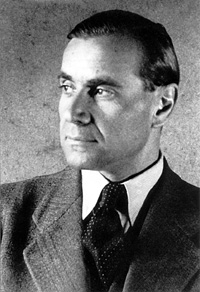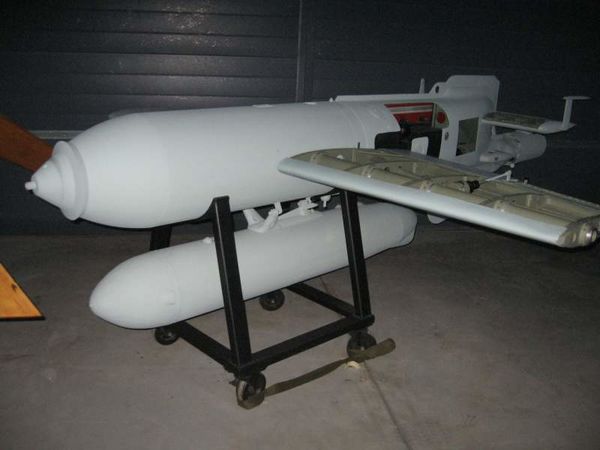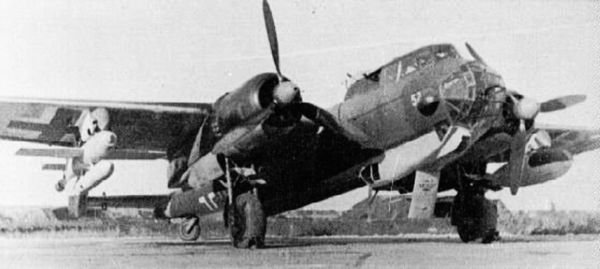The sweet surrender of a Nazi scientist -- Occupied Germany, 1945
Dec 1, 2016 19:01:20 #
When Nazi scientist Wernher von Braun surrendered to the U.S. Army in early May, 1945, another Nazi scientist, 45-year-old Herbert A. Wagner, was surrendering to a U.S. Navy intelligence team in nearby Oberammergau, Bavaria.
But Wagner experienced a very different kind of surrender.
Instead of months-long interrogations inside Germany, Wagner and his design team were whisked to the U.S. on a secret OSS plane (with blacked-out windows), landing in Frederick, Maryland on May 18, 1945. Wagner was the first Nazi scientist smuggled into America, beating von Braun by four months.
Six months earlier, President Roosevelt specifically prohibited the OSS from importing any Nazis, including scientists. But Roosevelt died on April 12, 1945. OSS took advantage of the ensuing turmoil.
"Surrender" seemed the wrong word for the cordial and respectful meeting between Wagner, the Naval intelligence team, and the OSS in Oberammergau. Wagner apparently had advance notice from the OSS, because he was waiting for them, all packed and ready to go. His "carry-on baggage included seven large cases of blueprints and tech info.
Wagner was a highly regarded scientist, well-known in naval circles. He earned an international reputation at age 23 with the publication of a scientific article defining an airfoil problem that eventually was named after him - the "Wagner Function."
The U.S. Navy's interest in Wagner was aroused in early 1943, when they realized he was behind a deadly new ship-sinking weapon - the Nazi Hs 293 guided air-to-surface missile.
This was a totally new approach - a remotely controlled winged torpedo launched from a bomber flying at 18,500 feet. The weapon's range from that height was almost ten nautical miles.
The 11-ft. long torpedo was hung under the wing or the belly of a bomber and was launched by the bombardier, who visually steered the weapon by radio while it silently glided at 300-plus mph toward the target. The stubby 10-ft. wingspan included small ailerons adjusted by the bombardier during the glide path.
Launching this 2,140-lb. weapon from under an aircraft in flight presented some problems, which were solved by attaching a small liquid-fueled rocket engine, used for only ten seconds at launch.
The Nazis reported that 2,300 glide bombs, built by the Henschel Flugzeugwerke, sank some 400,000 tons of Allied vessels.
Wagner brought plans and brainpower to the U.S. but he lacked an actual Hs 293 glide bomb. Then...surprise! On the same date as Wagner's touchdown in Maryland, a Nazi submarine (U-234) surrendered to the U.S. destroyer "Sutton" off the coast of Newfoundland. The sub was packed with gifts intended for the Japanese military: uranium and advanced weaponry -- including an intact Hs 293 glide bomb!
Wagner and his team were quickly assigned to the Special Devices Center, a research lab run by the Navy. Instead of the dusty desert environment surrounding the von Braun team in the American Southwest, Wagner found himself amid the luxurious grounds of the former estate of the Guggenheims, Castle Gould and Hempstead House, at Sands Point, Long Island.
Wagner reportedly often worked 12-hour days, for a salary of $27.30 per day. Eventually he was transferred to a new facility at Point Mugu, California - the Naval Missile Test Center, heart of the Navy's research into guided missiles. His research produced control systems designs that provided the foundations for modernized weapons still in use,
After leaving his Navy job, Wagner set up his own technical consulting firm, which he sold to Curtiss-Wright in 1957 before returning to Germany for a professorship post. He died in 1982 at age 82.
The FBI's classified counterintelligence report on Wagner included these excerpts: "An excellent German scientist of good character and who is not interested in politics ... Once belonged to the German SS for a four week's instruction course but dropped out...on his own volition."
Okay. If you say so.
But Wagner experienced a very different kind of surrender.
Instead of months-long interrogations inside Germany, Wagner and his design team were whisked to the U.S. on a secret OSS plane (with blacked-out windows), landing in Frederick, Maryland on May 18, 1945. Wagner was the first Nazi scientist smuggled into America, beating von Braun by four months.
Six months earlier, President Roosevelt specifically prohibited the OSS from importing any Nazis, including scientists. But Roosevelt died on April 12, 1945. OSS took advantage of the ensuing turmoil.
"Surrender" seemed the wrong word for the cordial and respectful meeting between Wagner, the Naval intelligence team, and the OSS in Oberammergau. Wagner apparently had advance notice from the OSS, because he was waiting for them, all packed and ready to go. His "carry-on baggage included seven large cases of blueprints and tech info.
Wagner was a highly regarded scientist, well-known in naval circles. He earned an international reputation at age 23 with the publication of a scientific article defining an airfoil problem that eventually was named after him - the "Wagner Function."
The U.S. Navy's interest in Wagner was aroused in early 1943, when they realized he was behind a deadly new ship-sinking weapon - the Nazi Hs 293 guided air-to-surface missile.
This was a totally new approach - a remotely controlled winged torpedo launched from a bomber flying at 18,500 feet. The weapon's range from that height was almost ten nautical miles.
The 11-ft. long torpedo was hung under the wing or the belly of a bomber and was launched by the bombardier, who visually steered the weapon by radio while it silently glided at 300-plus mph toward the target. The stubby 10-ft. wingspan included small ailerons adjusted by the bombardier during the glide path.
Launching this 2,140-lb. weapon from under an aircraft in flight presented some problems, which were solved by attaching a small liquid-fueled rocket engine, used for only ten seconds at launch.
The Nazis reported that 2,300 glide bombs, built by the Henschel Flugzeugwerke, sank some 400,000 tons of Allied vessels.
Wagner brought plans and brainpower to the U.S. but he lacked an actual Hs 293 glide bomb. Then...surprise! On the same date as Wagner's touchdown in Maryland, a Nazi submarine (U-234) surrendered to the U.S. destroyer "Sutton" off the coast of Newfoundland. The sub was packed with gifts intended for the Japanese military: uranium and advanced weaponry -- including an intact Hs 293 glide bomb!
Wagner and his team were quickly assigned to the Special Devices Center, a research lab run by the Navy. Instead of the dusty desert environment surrounding the von Braun team in the American Southwest, Wagner found himself amid the luxurious grounds of the former estate of the Guggenheims, Castle Gould and Hempstead House, at Sands Point, Long Island.
Wagner reportedly often worked 12-hour days, for a salary of $27.30 per day. Eventually he was transferred to a new facility at Point Mugu, California - the Naval Missile Test Center, heart of the Navy's research into guided missiles. His research produced control systems designs that provided the foundations for modernized weapons still in use,
After leaving his Navy job, Wagner set up his own technical consulting firm, which he sold to Curtiss-Wright in 1957 before returning to Germany for a professorship post. He died in 1982 at age 82.
The FBI's classified counterintelligence report on Wagner included these excerpts: "An excellent German scientist of good character and who is not interested in politics ... Once belonged to the German SS for a four week's instruction course but dropped out...on his own volition."
Okay. If you say so.
Dr. Herbert A. Wagner (1900-1982)

Hs 293 winged glide torpedo (rocket engine beneath burns only 10 seconds at launch)

Hs 293 glide bomb attached under wing of Dornier Do-217K-3 bomber (WW II)

Hempstead House on Long land became Wagner's workplace in 1945

Dec 1, 2016 19:38:44 #
Dec 1, 2016 19:55:52 #
Dec 2, 2016 04:07:31 #
Dec 2, 2016 06:00:31 #
Excellent post I didn't realise the germans were so advanced. Which theatre of the war were they used to sink the shipping?
Dec 2, 2016 06:47:30 #
richosob
Loc: Lambertville, MI
RichardQ wrote:
When Nazi scientist Wernher von Braun surrendered ... (show quote)
Thank you Richard for yet another great history lesson. I have watched many documentaries and stories related to world War 2 but there was never a mention of this "glide bomb". I would think a weapon this advanced in 1943 would have been mentioned in these documentaries. Thanks for the post, always look forward to reading them.
Rich
Dec 2, 2016 06:52:28 #
Thanks for another interesting article. The enemies who have something of value to offer after the war get a free ride, while the commoners get a free ride at the end of a rope. I wonder if we would have been ahead of Russia in the space race if we had done a better job of finding German rocket scientists.
Dec 2, 2016 07:57:19 #
My father was part of the team that rescued von Braun. Dad also said that von Braun was in a truck that was loaded with explosives and designed to explode and kill all aboard but the trigger didn't work. Dad also went behind German lines twice in German uniform. His name was Milton Brockmeyer. I would be very interested if you have any additional information.
Thank you
Thank you
Dec 2, 2016 12:27:07 #
Dec 2, 2016 13:12:27 #
I believe that HMS Warspite was hit by one, destroying a boiler room, but not sinking the ship.
Dec 2, 2016 17:14:21 #
usnpilot wrote:
Very interesting, thanks for the post.
Thank you for your interest, usnpilot! And thank you for your service. Personally, I was a sergeant in the Army Air Forcr in WW II, from 1945 to 1947, serving in Occupied Germany.
Dec 2, 2016 17:16:11 #
Camlane wrote:
Thanks for your usual great work!
Thank you for your comment and the compliment, Camlane!
Dec 2, 2016 17:27:19 #
Is it me or does the Hempstead House on Long Island look like Professor Xavier's mansion from the X Men's movies?
Dec 2, 2016 17:46:30 #
Leicaflex wrote:
As always, a very interesting and informative post.
Thank you.
Thank you.
Many thanks for your gracious comments, Leicaflex! I try to remind people that a lot of action was going on during those Occupation years.
Dec 2, 2016 20:40:13 #
I deeply love your history stories. They bring forth great history lessons our youth are not receiving. They do show the bad side and the good side of WWII. Mahalo for sharing this little known part of history.
If you want to reply, then register here. Registration is free and your account is created instantly, so you can post right away.









